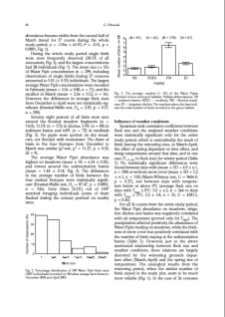
Obiekt
Tytuł: Breeding Bird Community of a Primeval Temperate Forest (Białowieża National Park, Poland) at the Beginning of the 21st Century
Twórca:
Wesołowski, Tomasz ; Rowiński, Patryk ; Mitrus, Cezary ; Czeszczewik, Dorota
Data wydania/powstania:
Typ zasobu:
Inny tytuł:
Zgrupowanie ptaków lęgowych pierwotnego lasu Białowieskiego Parku Narodowego na początku XXI wieku ; Bird community of a primeval forest
Współtwórca:
Museum and Institute of Zoology, Polish Academy of Sciences
Wydawca:
Museum and Institute of Zoology, Polish Academy of Sciences
Miejsce wydania:
Opis:
Typ obiektu:
Abstrakt:
The 2000–2004 results of the mapping technique censuses carried out in permanent plots situated in three types of old-growth primeval BNP stands (ash-alder riverine, oak-hornbeam, mixed coniferous) are presented and compared with data gathered in the same plots in the late 1990s. These data supplement earlier observations in the BNP and extend the long-term set of data on the breeding bird numbers there to a 30-year uninterrupted series (1975–2004). Most community parameters, such as the composition of breeding avifauna, the species richness, and the make-up and cumulative share of dominants, have remained basically unchanged. The overall bird density has increased by 8–20% in different plots; in 2001 it reached the highest level within the 30-year study period. The increase was due to parallel increases in numbers of several species, widely differing in their nesting sites, food requirements and migratory habits — during this period 14 of the 26 most numerous species attained their highest numbers in the 30-year study period. Since numbers increased simultaneously in all the plots, the density differences across habitats remained the same, from the highest densities in riverine stands at the forest edge (up to 149 p/10 ha), through oak-hornbeam stands, to the lowest densities in the coniferous stands (54–56 p/10 ha). In most cases the numerical increases could not be attributed to changes in local environmental factors, such as food resources, or to detectable changes in habitat structure. The apparent lack of a relationship between the changes in bird numbers and the local situation suggests that factors acting on a larger scale (beyond the study area) could have been involved. Despite the directional changes in bird abundance observed in the Białowieża Forest, its breeding bird assemblage, when compared with the amplitude of changes recorded over the same period in other areas and habitats, stands out as an example of remarkable stability.
Czasopismo/Seria/cykl:
Tom:
Zeszyt:
Strona pocz.:
Strona końc.:
Szczegółowy typ zasobu:
Format:
Identyfikator zasobu:
oai:rcin.org.pl:55566 ; 10.3161/068.041.0112
Źródło:
MiIZ PAN, sygn. P.4568 ; MiIZ PAN, sygn. P.257 ; kliknij tutaj, żeby przejść
Język:
Język streszczenia:
Prawa:
Prawa zastrzeżone - dostęp ograniczony
Zasady wykorzystania:
Digitalizacja:
Muzeum i Instytut Zoologii Polskiej Akademii Nauk
Lokalizacja oryginału:
Biblioteka Muzeum i Instytutu Zoologii PAN
Dostęp:
Kolekcje, do których przypisany jest obiekt:
- Muzeum i Instytut Zoologii PAN > Czasopisma
- Muzeum i Instytut Zoologii PAN > Wydawnictwa MiIZ PAN > Acta Ornithologica
Data ostatniej modyfikacji:
8 sie 2023
Data dodania obiektu:
29 lip 2015
Liczba pobrań / odtworzeń:
15
Wszystkie dostępne wersje tego obiektu:
https://rcin.org.pl/miiz/publication/75746
Wyświetl opis w formacie RDF:
Wyświetl opis w formacie RDFa:
Wyświetl opis w formacie OAI-PMH:
Obiekty Podobne
Wesołowski, Tomasz (1950– ) Tomiałojć, Ludwik (1939– ) Mitrus, Cezary Rowiński, Patryk Czeszczewik, Dorota
Tomiałojć, Ludwik (1939– ) Wesołowski, Tomasz (1950– )
Mitrus, Cezary Walankiewicz, Wiesław Czeszczewik, Dorota Jabłoński, Piotr M.
Walankiewicz, Wiesław Czeszczewik, Dorota Mitrus, Cezary Szymura, Arkadiusz
Walankiewicz, Wiesław Mitrus, Cezary Czeszczewik, Dorota Jabłoński, Piotr M.
Wesołwski, Tomasz Czeszczewik, Dorota Rowiński, Patryk
Hillbricht-Ilkowska, Anna
Rybak, Joanna

 INSTYTUT ARCHEOLOGII I ETNOLOGII POLSKIEJ AKADEMII NAUK
INSTYTUT ARCHEOLOGII I ETNOLOGII POLSKIEJ AKADEMII NAUK
 INSTYTUT BADAŃ LITERACKICH POLSKIEJ AKADEMII NAUK
INSTYTUT BADAŃ LITERACKICH POLSKIEJ AKADEMII NAUK
 INSTYTUT BADAWCZY LEŚNICTWA
INSTYTUT BADAWCZY LEŚNICTWA
 INSTYTUT BIOLOGII DOŚWIADCZALNEJ IM. MARCELEGO NENCKIEGO POLSKIEJ AKADEMII NAUK
INSTYTUT BIOLOGII DOŚWIADCZALNEJ IM. MARCELEGO NENCKIEGO POLSKIEJ AKADEMII NAUK
 INSTYTUT BIOLOGII SSAKÓW POLSKIEJ AKADEMII NAUK
INSTYTUT BIOLOGII SSAKÓW POLSKIEJ AKADEMII NAUK
 INSTYTUT CHEMII FIZYCZNEJ PAN
INSTYTUT CHEMII FIZYCZNEJ PAN
 INSTYTUT CHEMII ORGANICZNEJ PAN
INSTYTUT CHEMII ORGANICZNEJ PAN
 INSTYTUT FILOZOFII I SOCJOLOGII PAN
INSTYTUT FILOZOFII I SOCJOLOGII PAN
 INSTYTUT GEOGRAFII I PRZESTRZENNEGO ZAGOSPODAROWANIA PAN
INSTYTUT GEOGRAFII I PRZESTRZENNEGO ZAGOSPODAROWANIA PAN
 INSTYTUT HISTORII im. TADEUSZA MANTEUFFLA POLSKIEJ AKADEMII NAUK
INSTYTUT HISTORII im. TADEUSZA MANTEUFFLA POLSKIEJ AKADEMII NAUK
 INSTYTUT JĘZYKA POLSKIEGO POLSKIEJ AKADEMII NAUK
INSTYTUT JĘZYKA POLSKIEGO POLSKIEJ AKADEMII NAUK
 INSTYTUT MATEMATYCZNY PAN
INSTYTUT MATEMATYCZNY PAN
 INSTYTUT MEDYCYNY DOŚWIADCZALNEJ I KLINICZNEJ IM.MIROSŁAWA MOSSAKOWSKIEGO POLSKIEJ AKADEMII NAUK
INSTYTUT MEDYCYNY DOŚWIADCZALNEJ I KLINICZNEJ IM.MIROSŁAWA MOSSAKOWSKIEGO POLSKIEJ AKADEMII NAUK
 INSTYTUT PODSTAWOWYCH PROBLEMÓW TECHNIKI PAN
INSTYTUT PODSTAWOWYCH PROBLEMÓW TECHNIKI PAN
 INSTYTUT SLAWISTYKI PAN
INSTYTUT SLAWISTYKI PAN
 SIEĆ BADAWCZA ŁUKASIEWICZ - INSTYTUT TECHNOLOGII MATERIAŁÓW ELEKTRONICZNYCH
SIEĆ BADAWCZA ŁUKASIEWICZ - INSTYTUT TECHNOLOGII MATERIAŁÓW ELEKTRONICZNYCH
 MUZEUM I INSTYTUT ZOOLOGII POLSKIEJ AKADEMII NAUK
MUZEUM I INSTYTUT ZOOLOGII POLSKIEJ AKADEMII NAUK
 INSTYTUT BADAŃ SYSTEMOWYCH PAN
INSTYTUT BADAŃ SYSTEMOWYCH PAN
 INSTYTUT BOTANIKI IM. WŁADYSŁAWA SZAFERA POLSKIEJ AKADEMII NAUK
INSTYTUT BOTANIKI IM. WŁADYSŁAWA SZAFERA POLSKIEJ AKADEMII NAUK
































